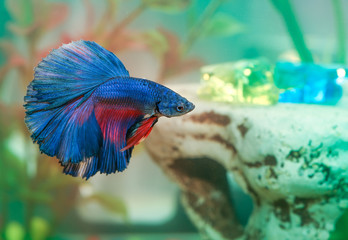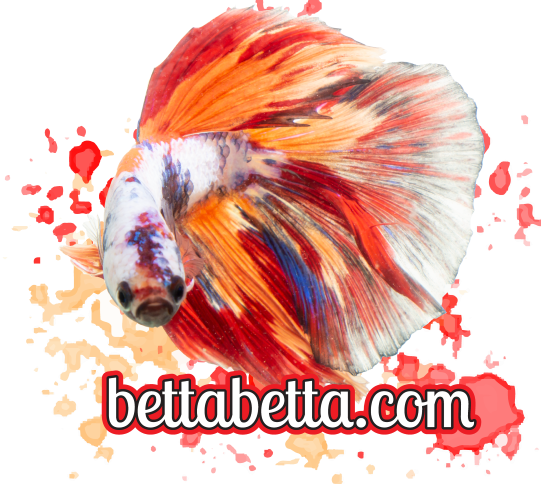Does your betta fish look sad? Do they often rest at the bottom of the aquarium? Your fish may be bored or even sick. It is believed that the maintenance of fighting fish is reduced. Or that they do not require any, but this is false. There are ways you can keep your betta fish happy and healthy.
Look for signs of Illness
Know what it looks like and how a healthy betta fish behaves. A healthy fish has a good appetite, it swims and is active, it is colorful and bright, its fins and tail spread like a fan and it has smooth and clean scales and body.
Know what looks and how a sick fighting fish behaves. They can sometimes seem sad because they’re sick. Check the temperature of the aquarium. Examine the water if your fighter is lethargic. You should change the water or increase the heating.
Here are the signs of disease in a betta:
- they don’t eat or reluctantly
- it is inactive, it stands in a corner of the aquarium, is lying at the bottom or is constantly on the surface
- they deliberately bump into objects as if they were trying to scratch
- it looks pale, gray or generally dull in color
- tail and/or fins are frayed, closed, stiff in appearance or falling apart
- the body has open sores, whitish and cottony patches, red or white spots or swelling
- eyes appear protruding or swollen
- the gills do not close completely and remain ajar(they may appear swollen or red)
- scales are erect like a pine cone
- belly may appear either hollow or dilated and swollen

Diagnose the disease of your pet.
There are several common diseases in them that can be treated if diagnosed correctly. But you should know exactly what your fighter is suffering from before starting treatment. Some drugs work for all kinds of pathologies in fish, but make sure you get the right one. Here are some of the most common diseases in fish.
- A fungal infection: observe whitish and cottony patches on the body and head, closed gills, pale color, and reduced activity.
- Erosion of the tail and/or fins: see if the tail and fins shrink, fray, are darker in color if the fish is less active, and only eat reluctantly.
- Ichthyophtiriosis: observe small white dots (as if the body was strewn with salt), reduced activity, and less appetite as well as the need to rub against rocks or plants.
- Vibriosis: observe reduced activity, loss of appetite, and duller color. Vibriosis is caused by a parasite and can be difficult to detect. You should, therefore, use a light torch to notice a fine, golden, or rust-colored mold on the body of the fish.
- Dropsy: observe a fairly large and distended belly and scales that are erect as on a pine cone. This is unfortunately one of those diseases for which there is no recognized treatment. It is thought to be a bacteria that causes kidney failure and may be linked to feeding live worms to fish.
Isolation
Isolate your Betta to treat it. You should separate your sick fish from the common aquarium. Only if it lives with other fish or aquatic animals. Such as snails or frogs. You are not going to treat healthy fish or aquatic animals that are not sick, although a complete water change for the entire aquarium is a good idea if you have a sick fish. Your struggling finned friend should be isolated for up to three to four weeks while they recover. Go to the nearest pet store and find medicines to treat the various illnesses mentioned above. They will likely contain certain types of antibiotics (tetracycline).
Speak with the aquarium manager at the pet store or with a veterinarian. Do this if your fish looks sick and you don’t know what they are suffering from, especially before starting any treatment. You should not treat your fish fighter with drugs that are not appropriate. This can make it even sicker.

Create a good habitat for them
Choose a good environment for them. These fish need an aquarium with a capacity of at least thirty liters. Their water must also be heated to 25 ° C since they are tropical fish and must be fitted with a filter.
- Always make sure that your water heating system is working properly, as an appliance that heats up too much (over 26 ° C) is bad for fish and can harm it.
- A filter is essential. You should get one with reduced power. A conventional filter in a small aquarium can create too much backwater for the fish. Do not ventilate the aquarium, as this really creates too much movement in the water. Fighting fish are used to calm, almost currentless waters.
Keep the water clean. They are happiest when they have clean water, so you should make sure to change one-tenth of the water every week for an aquarium with a capacity of thirty liters and twice a week for those who contain twenty liters of water.
- Changing a tenth of the water means you should remove 10% of the water and replace it with the same amount of freshwater. Distilled or spring water is often used, but chlorine-free tap water can also do the trick.
- Contrary to popular belief, fighting fish do not survive in tiny puddles or muddy water. Their natural environments are rice fields and shallow rivers with a weak current. In most cases, a larger aquarium is always preferable.
Keep the aquarium away from direct sunlight and away from air conditioning. Direct lighting will make the water too hot for the fish and the proximity of air conditioning will make it too cold. Bettas are happiest when the water temperature remains stable at around 24 to 25 ° C.

Buying Decorations
Buy decorations for the aquarium. These fishes enjoy hiding places. The tunnels, caves, and plants (only real) all make excellent decorations for a fighting fish aquarium. If you opt for artificial plants, choose them in silk, because they will not damage the fins of fish. Live plants are very popular and your pet will love them. Just make sure they don’t grow too much for the size of the aquarium. You can cut them if this is the case. Your Betta fish must have easy access to the surface of the water to breathe, so you should not clutter up too much.
Buying Their Food
Buy food that is suitable for your fish. A well-nourished fighter is a happy fish. They are carnivores, so they need a diet rich in protein. There are several brands of fish food on the market that are specially designed for fighters and you should not give your fish food that is intended for another type of fish, even if it is tropical.
Granules are generally the type of food that is given to combat fish or flakes based on whole fish meal, shrimp, dried krill as well as vitamins, soybean sprouts, and/or flour. whole wheat. If you want to avoid unnecessary expenses, you can also feed your fighter with mosquito larvae, brown shrimp, and live worms or live and frozen or live and dried food. However, take extra care when you give the fighter live food for the reasons explained in step three. Make sure that these live foods are fresh (not rotten). Clean them(rinse them first with cool water)too. Or else they risk causing illnesses.
Feeding Them
Feed your fighter only once or twice a day. Give them only the amounts they can eat in two minutes. It’s very important. You should give them less to eat (only two to three pellets) each time if you feed them twice a day. Siamese fighting fishes have a small appetite. You therefore shouldn’t feed them too much. And uneaten food left in the aquarium will degrade water quality and can make your fighter ill.
Watch for signs of over-eating. You are probably giving your fighter too much to eat if their belly is prominent (they point a lot towards the rear fins). This can cause bladder problems in some species of fighters. Be especially wary of overeating if you give live prey to fish (mosquito larvae, gray shrimp, or live worms). Fish tend to overeat when given live food. You may not even feed your fighter one day a week to rest their digestive system.

Exchange with the fighter
Talk to them. Many Betta fishes can hear the voice of their master. You might notice that your fish is swimming more actively when you talk to them through the aquarium. You can also move your finger on the glass wall of the aquarium or wave it on the surface of the water. They will try to jump on it. Just make sure it won’t jump out of the aquarium. These creatures are very curious and they love to play! It can follow your progress in the room when you go around the aquarium.
Change its decorations or buy new ones. You give your fighter more variety and things to look at by having different backgrounds that you can swap.
See if you can present another fish to your Betta. If it is a female, she might enjoy the company of other females. We can speak here of an aquarium of female friends. Expect however to keep them in separate aquariums if they disagree.
You can definitely NOT put two male betta fishes together. They will attack each other. It’s why they are called Siamese fighting fishes. You can put a male betta fish with females for breeding. You should however leave that to professional aquarium breeders.
Carefully introduce the company for your fighter. Again. Some males and females will never get along with others in an aquarium. Possible aquarium companions can be small water snails, blue gourami (small freshwater fish), dwarf African frogs, translucent catfish, and fluorescent grouse.
Observe.
Observe the signs of agreement. If you present other fish or animals to the Betta in the aquarium, observe them closely. You will not necessarily see the betta fish busy attacking them. You should however take note that it remains necessary to monitor the health of the other fish or animals that you have introduced. Do they seem injured? Is one of them constantly hiding? These may be signs of the fighter’s aggressiveness towards your other fish or animals. Also, you should separate the betta fish from the other occupants of the aquarium. Treat injured fish first.

Make sure to avoid overly colorful and aggressive aquarium mates with long thin fins such as guppies. In addition, some types of fluorescent grouse, although generally suitable, also fin nibblers. You should inquire about the kind of fish you are thinking of having if you want a tetra as a companion for your Betta.

![240_F_312712853_A7ua4JISWQ40rGQ03int51auxQwrRrTR[1] betta](https://bettabetta.com/wp-content/uploads/2020/06/240_F_312712853_A7ua4JISWQ40rGQ03int51auxQwrRrTR1.jpg)
